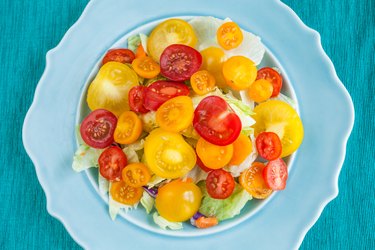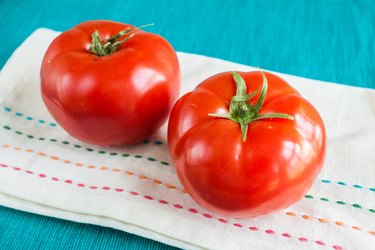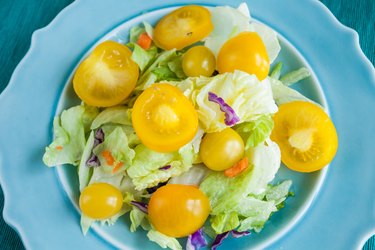
Tomatoes (Lycopersicon esculentum) were once thought to be poisonous and were grown only for decoration, possibly because of their kinship with a hallucination-producing cousin, deadly nightshade (Atropa belladonna). Now tomatoes are a beloved garden plant despite their high acid content (a pH lower than 4.6). Some varieties of heirloom tomatoes -- those introduced before 1940, have been in production for more than 50 years or were handed down through families -- are more disease-resistant than some commercial varieties and are lower in acid.
What Makes a Tomato Acidic
Video of the Day

Tomato flavor is determined by the balance of sugar and acid. Varieties with high sugars and low acid have a sweet taste. Those with low sugar and low acids are bland, and those with high sugars and high acid have the best tomatoey flavor. But sometimes tomatoes can be too acidic and cause intestinal upset. Several conditions can reduce the acid in tomatoes, such as tomatoes grown in the shade and at lower temperatures or picking tomatoes off dead vines vs. green vines. But some varieties of tomatoes are naturally low-acid yet still have that sweet, rich tomato flavor.
Video of the Day
Heirloom Tomatoes

Ace 55 (Lycopersicon esculentum "Ace 55") is a midseason heirloom variety of tomato with large, deep red fruit and a rich flavor despite being lower in acid. It matures in about 75 days, and the crack-resistant fruits weigh in at 12 to 14 ounces apiece. The large leaves on the 3- to 4-foot tall plant shade the fruits from sunburn. Ace 55 is resistant to verticillium wilt, fusarium wilt and alternaria stem canker.
Big Rainbow (Lycopersicon esculentum "Big Rainbow") takes a little longer to mature, nearly 90 days but is worth the wait. Fruit can grow to weigh 2 pounds with a rich, sweet flavor. When sliced, the meat is streaked with neon-red color. It is resistant to foliar diseases and cracking.
Yellow and Orange Tomatoes

Yellow and orange tomatoes have long been considered lower in acid, but that's not always true. Only certain varieties are truly lower-acid tomatoes. The variety Persimmon (Lycopersicon esculentum "Persimmon") matures in about 79 days and produces 12-ounce to 2-pound persimmon-colored fruit. This is a beefsteak-style tomato and is resistant to many common tomato diseases.
Mandarin Cross (Lycopersicon esculentum "Mandarin Cross") is an attractive tomato both in the garden and on the table. Mature in about 76 days, this heirloom variety from Japan produces round, orange-gold globe-shaped fruit with a sweet flavor. These tall plants are robust and prolific and resistant to fusarium and verticillium wilt and nematodes.
Salad Tomatoes

Small tomatoes are good as garnishes for salads or snacks. Yellow Pear (Lycopersicon esculentum "Yellow Pear") is a lemon-yellow, pear-shaped tomato that reaches 1 ½ inches in length. Grown since the 1700s, it matures in about 75 days. These midseason, 6- to 7-foot plants spread 2 to 3 feet and are very prolific. The fruit has a sweet flavor.
Another yellow tomato, Yellow Plum (Lycopersicon esculentum "Yellow Plum"), produces its 1 ½-inch fruit in clusters and has a sweet but mild flavor. Maturity is in about 70 days from transplanting.
- Contra Costa Master Gardeners: University of California Cooperative Extension: Heirloom Tomato Varieties Available at the 2014 Great Tomato Plant Sale
- Harvest to Table: Orange and Yellow Low Acid Tomatoes for Breakfast
- Clemson Cooperative Extension: Tomato
- Bonnie Plants: The Basics of Tomato Flavor
- Colorado State University: Canning Tomatoes and Tomato Products
- Bonnie Plants: Ace 55 Tomato
- San Diego County Master Gardener Association: Heirloom Tomatoes: Fruit With a History of Great Taste
- U&D Nursery: Tomatoes for 2012